Maca (Lepidium Meyenii Walpers) is a taproot plant from the Brassicaceae family. It has been grown as a food crop and for its medicinal properties since the Neolithic era in the High Andes in Peru, at an altitude of 3,500 to 4,200 meters. This tuber is one of the very rare plants able to survive in the extreme climatic conditions common on the high Andean plateaux, with relentless sun and high temperatures during the day, intense frost at night, and sustained violent winds that parch most plants and considerable soil erosion, creating semi-desert conditions.
Maca was first used by the Incas over 2,000 years ago when it was an integral part of the Andean diet and trade. When the Incas controlled the South American region, they found maca so powerful that its use was reserved for their royal court. Nowadays in Peru, maca is used raw, cooked, or dried and processed as an ingredient in biscuits, cakes, crisps, and drinks.
It is also sold and used for its energy-boosting properties. It is commonly called “Peruvian ginseng” since it is said to stimulate libido. It is also known to increase natural energy and muscle tone, as well as physical performance. Maca now has an international reputation.
Hydrolyzed Lepidium Meyenii Root is obtained directly from tuber flour, using a special bio-enzymatic process. The flour is treated with a specific enzyme mix, in order to obtain a hydrolyzate containing peptides and sugars. The process is completed by an ultrafiltration phase, designed to eliminate any residual traces of protein. Finally, the preservative system is added (1% phenoxyethanol, 0,08% sorbic acid).Hydrolyzed Lepidium Meyenii Root boosts the proliferation ability of aged fibroblasts, increasing the skin cell population and fighting against aging-related changes. Prolonged usage of skincare products containing Hydrolyzed Lepidium Meyenii Root increases skin's complexion radiance and luminosity.










